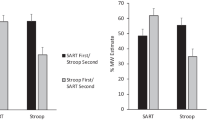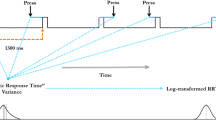Abstract
This study investigated the differential influence of hypnotic susceptibility level on signal detection task (SDT) performance in waking and hypnotic conditions. As assessed by the Harvard Group Scale of Hypnotic Susceptibility, Form A (HGSHS: A) and the Stanford Hypnotic Susceptibility Scale, Form C (SHSS: C), 20 high (9–12), 20 medium (4–8), and 20 low (0–3) hypnotizables participated. In counterbalanced conditions of waking and hypnosis, Ss (Subjects) were given 36 signal detection trials, consisting of 12 strong signals, 12 weak signals, and 12 “no” signals. No differences were observed in the waking condition between low, medium, and high hypnotizables on strong and weak signal trials. In hypnosis, high hypnotizables exhibited significantly superior performance on the strong signal trials in comparison with low hypotizables, and performed significantly better on the weak signal trials than did the low and medium hypnotizables. Low and medium hypnotizables performed similarly in waking and hypnotic conditions, while high hypnotizables showed significant enhancements in performance for strong and weak signal trials during hypnosis.
Similar content being viewed by others
References
Atkinson, R. P., & Crawford, H. J. (1988, August).Afterimage persistence: Relationships to hypnotic responsiveness and visuo-spatial ability. Paper presented at the annual meeting of the American Psychological Association, Atlanta, Georgia.
Atkinson, R. P., & Sewell, M. M. (1988). Enhancement of visual perception under conditions of short-term exposure to sensory isolation: A comparison of procedures for altering vigilance.Perceptual and Motor Skills, 67, 243–252.
Blum, G. S., & Porter, M. L. (1974). Effects of the restriction of conscious awareness in a reaction-time task.International Journal of Clinical and Experimental Hypnosis, 22, 335–345.
Crawford, H. J. (1981). Hypnotic susceptibility as related to gestalt closure tasks.Journal of Personality and Social Psychology, 40, 376–383.
Crawford, H. J. (1982). Hypnotizability, daydreaming style, imagery vividness, and absorption: A multidimensional study.Journal of Personality and Social Psychology, 42, 915–926.
Crawford, H. J. (1983). Enhanced visual memory during hypnosis as mediated by hypnotic responsiveness and cognitive strategies.Journal of Experimental Psychology: General, 112, 662–685.
Crawford, H. J., & Allen, S. N. (1983). Enhanced visual memory during hypnosis as mediated by hypnotic responsiveness and cognitive strategies.Journal of Experimental Psychology: General, 112, 662–685.
Crawford, H. J., MacDonald, H., & Hilgard, E. R. (1979). Hypnotic deafness: A psychophysiological study of responses to tone intensity as modified by hypnosis.American Journal of Psychology, 92, 193–214.
Crawford, H. J., Wallace, B., Nomura, K., & Slater, H. (1986). Eidetic-like imagery in hypnosis: Rare but there.American Journal of Psychology, 99, 527–546.
Graham, C., & Evans, F. J. (1977). Hypnotizability and the development of waking attention.Journal of Abnormal Psychology, 86, 631–638.
Graham, C., & Leibowitz, H. W. (1972). The effect of suggestion on visual acuity.International Journal of Clinical and Experimental Hypnosis, 20, 169–186.
Karlin, R. A. (1979). Hypnotizability and attention.Journal of Abnormal Psychology, 88, 92–95.
Sheehan, E. P., Smith, H. V., & Forest, D. W. (1982). A signal detection study of the effects of suggested improvement on the monocular visual acuity of myopes.International Journal of Clinical and Experimental Hypnosis, 30, 138–146.
Sheehan, P. W. (1979). Hypnosis and the process of imagination. In E. Fromm & R. E. Shor (Eds.),Hypnosis: Developments in research and new perspectives. Chicago: Aldine.
Sheehan, P. W. (1982). Imagery and hypnosis: Forging a link, at least in part.Research Communications in Psychology, Psychiatry and Behavior, 7, 257–272.
Shor, R. E., & Orne, E. C. (1962).Harvard Group Scale of Hypnotic Susceptibility, Form A. Palo Alto, CA: Consulting Psychologists Press.
Spanos, N. P., Ansari, F., & Stam, H. J. (1979). Hypnotic age regression and eidetic imagery: A failure to replicate.Journal of Abnormal Psychology, 88, 88–91.
Spanos, N. P., Rivers, S. M., & Gottlieb, J. (1978). Hypnotic responsivity, mediation and laterality of eye movements.Journal of Abnormal Psychology, 87, 566–569.
Spanos, N. P., Stam, H. J., Rivers, S. M., & Radtke, H. L. (1980). Meditation, expectation and performance on indices of nonanalytic attending.International Journal of Clinical and Experimental Hypnosis, 28, 244–251.
Tellegen, A., & Atkinson, G. (1974). Openness to absorbing and self-altering experiences (“absorption”), a trait related to hypnotic susceptibility.Journal of Abnormal Psychology, 83, 268–277.
Van Nuys, D. (1973). Meditation, attention, and hypnotic susceptibility: A correlational study.International Journal of Clinical and Experimental Hypnosis, 21, 56–69.
Wallace, B. (1979). Hypnotic susceptibility and the perception of afterimages and dot stimuli.American Journal of Psychology, 92, 681–691.
Wallace, B., & Fisher, L. E. (1982). Hypnotically induced limb anesthesia and adaptation to displacing prisms.Journal of Abnormal Psychology, 91, 390–391.
Wallace, B., & Hoyenga, K. B. (1980). Reduction of proprioceptive errors with induced hypnotic anesthesia.International Journal of Clinical and Experimental Hypnosis, 28, 140–147.
Weitzenhoffer, A. M., & Hilgard, E. R. (1962).Stanford Hypnotic Susceptibility Scale, Form C. Palo Alto, CA: Consulting Psychologists Press.
Author information
Authors and Affiliations
Additional information
This research was supported, in part, by a grant from Fort Hays State University.
Rights and permissions
About this article
Cite this article
Atkinson, R.P., Hustead, R.J. Moderating influences of hypnotic susceptibility on signal-detection task performance. Current Psychology 11, 195–202 (1992). https://doi.org/10.1007/BF02686840
Accepted:
Issue Date:
DOI: https://doi.org/10.1007/BF02686840




